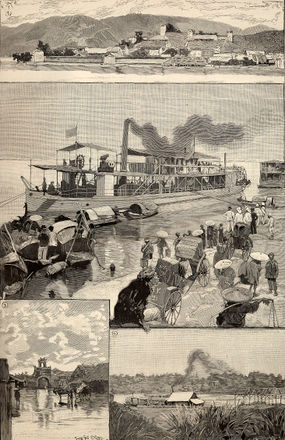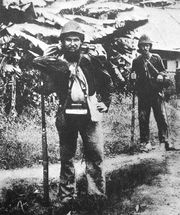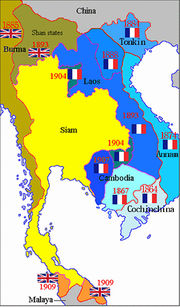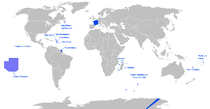French Indochina

Indochina in 1891 (from Le Monde Illustré).
1. Panorama of Lac-Kaï, French outpost in China. 2. Yun-nan, in the quay of Hanoi. 3. Flooded street of Hanoi. 4. Landing stage of Hanoi French Indochina (French: Indochine française; Vietnamese: Đông Dương thuộc Pháp, pronounced [ɗoŋm zɰəŋ tʰuə̀k fǎp], frequently abbreviated to Đông Pháp) was part of the French colonial empire in southeast Asia. A federation of the three Vietnamese regions, Tonkin (North), Annam (Central), and Cochinchina (South), as well as Cambodia, was formed in 1887. Laos was added in 1893 and Kouang-Tchéou-Wan in 1900. The capital was moved from Saigon (in Cochinchina) to Hanoi (Tonkin) in 1902. During World War II, the colony was administered by Vichy France and was under Japanese occupation. Beginning in May 1941, the Viet Minh, a communist army led by Ho Chi Minh, began a revolt against French rule known as the First Indochina War. In Saigon, the anti-Communist State of Vietnam, led by former Emperor Bảo Đại, was granted independence in 1949. Following the Geneva Accord of 1954, the Viet Minh became the government of North Vietnam, although the Bảo Đại government continued to rule in the South. The colonial administration of Annam was dissolved in 1955 and the region was split between North and South, as provided for in the Geneva Accord.
First French interventionsFrance-Vietnam relations started as early as the 17th century with the mission of the Jesuit, Father Alexandre de Rhodes. At this time, Vietnam was only just beginning to occupy the Mekong Delta, former territory of the Indianized kingdom of Champa they had defeated in 1471.[1] European involvement in Vietnam was confined to trade during the 18th century. In 1787, Pigneau de Béhaine petitioned the French government and organized French military volunteers to aid Nguyễn Ánh in retaking lands lost to the Tây Sơn. Pigneau died in Viet Nam, his troops fought on until 1802. France was heavily involved in Vietnam in the 19th century; protecting the work of the Paris Foreign Missions Society in the country was often presented as a justification. For its part, the Nguyễn Dynasty increasingly saw Catholic missionaries as a political threat; courtesans, for example, an influential faction in the dynastic system, feared for their status in a society influenced by an insistence on monogamy. In 1858, the brief period of unification under the Nguyễn Dynasty ended with a successful attack on Da Nang by Charles Rigault de Genouilly. Diplomat Charles de Montigny's mission having failed, Genouilly's mission was to stop attempts to expel Catholic missionaries. His orders, from Napoleon III, were to stop the persecution of missionaries and assure the unimpeded propagation of the faith.[2] In September, 14 French gunships, 3,000 men and 300 Filipino troops provided by the Spanish,[3] attacked the port of Tourane (present day Da Nang), causing significant damages, and occupying the city. After a few months, Rigault had to leave the city due to supply issues and illnesses.[2] Sailing south, De Genouilly then captured the poorly defended city of Sai Gon (present day Ho Chi Minh City), on 18 February 1859. On 13 April 1862, the Vietnamese government was forced to cede the territories of Biên Hòa, Gia Định and Dinh Tuong to France. De Genouilly was criticized for his actions and was replaced by Admiral Page in November 1859, with instructions to obtain a treaty protecting the Catholic faith in Vietnam, but not to try to obtain territorial gains.[2] However, French policy four years later saw a reversal; French territory in Viet Nam continued to accumulate. In 1862, France obtained concessions from Emperor Tự Đức, ceding three treaty ports in Annam and Tonkin, and all of Cochinchina, the latter being formally declared a French territory in 1864. In 1867 the provinces of Chau Doc, Ha Tien and Vĩnh Long were added to French controlled territory. In 1863, the Cambodian king Norodom had requested the establishment of a French protectorate over his country. In 1867, Siam (modern Thailand) renounced suzerainty over Cambodia and officially recognized the 1863 French protectorate on Cambodia, in exchange for the control of Battambang and Siem Reap provinces which officially became part of Thailand (These provinces would be ceded back to Cambodia by a border treaty between France and Siam in 1906). Establishment of French Indochina
French marine infantrymen in Tonkin, 1884

Expansion of French Indochina (in blue).
France obtained control over northern Vietnam following its victory over China in the Sino-French war (1884–1885). French Indochina was formed in October 1887 from Annam, Tonkin, Cochinchina (which together form modern Vietnam) and the Kingdom of Cambodia; Laos was added after the Franco-Siamese War. The federation lasted until 1954. In the four protectorates, the French formally left the local rulers in power, who were the Emperors of Vietnam, Kings of Cambodia, and Kings of Luang Prabang, but in fact gathered all powers in their hands, the local rulers acting only as figureheads. Vietnamese rebellionsFrench troops landed in Vietnam in 1858 and by the mid 1880s they had established a firm grip over the northern region. From 1885 to 1895, Phan Đình Phùng led a rebellion against the colonizing power. Nationalist sentiments intensified in Vietnam, especially during and after World War I, but all the uprisings and tentative efforts failed to obtain any concessions from the French overseers. Franco-Siamese war (1893)
Siamese army in the disputed territory of Laos in 1893.
Territorial conflict in the Indochinese peninsula for the expansion of French Indochina led to the Franco-Siamese War of 1893. In 1893 the French authorities in Indochina used border disputes, followed by the Paknam naval incident, to provoke a crisis. French gunboats appeared at Bangkok, and demanded the cession of Lao territories east of the Mekong. King Chulalongkorn appealed to the British, but the British minister told the King to settle on whatever terms he could get, and he had no choice but to comply. Britain's only gesture was an agreement with France guaranteeing the integrity of the rest of Siam. In exchange, Siam had to give up its claim to the Tai-speaking Shan region of north-eastern Burma to the British, and cede Laos to France. Further encroachments on Siam (1904–1907)
Occupation of Trat by French troops in 1904.
The French, however, continued to pressure Siam, and in 1906–1907 they manufactured another crisis. This time Siam had to concede French control of territory on the west bank of the Mekong opposite Luang Prabang and around Champasak in southern Laos, as well as western Cambodia. France also occupied the western part of Chantaburi. In 1904, in order to get back Chantaburi Siam had to give Trat to French Indochina. Trat became part of Thailand again on March 23, 1906 in exchange for many areas east of the Mekong river like Battambang, Siam Nakhon and Sisophon. .jpg)
French Indochina in 1913.
In the 1930s, Siam engaged France in a series of talks concerning the repatriation of Siamese provinces held by the French. In 1938, under the Front Populaire administration in Paris, France had agreed to repatriate Angkor Wat, Angkor Thom, Siam Reap, Siam Pang and the associated provinces (approximately 13) to Siam. Meanwhile, Siam took over control of those areas, in anticipation of the upcoming treaty. Signatories from each country were dispatched to Tokyo to sign the treaty repatriating the lost provinces. Viet Nam Quoc Dan DangOn February 10, 1930, there was an uprising by Vietnamese soldiers in the French colonial army's Yen Bai garrison. The Yên Bái mutiny was sponsored by the Việt Nam Quốc Dân Đảng (VNQDD). The VNQDD was the Vietnamese Nationalist Party. The attack was the largest disturbance brewed up by the Can Vuong monarchist restoration movement of the late 19th century. The aim of the revolt was to inspire a wider uprising among the general populace in an attempt to overthrow the colonial authority. The VNQDD had previously attempted to engage in clandestine activities to undermine French rule, but increasing French scrutiny on their activities led to their leadership group taking the risk of staging a large scale military attack in the Red River Delta in northern Vietnam. French-Thai War (1940–1941)Main article: French-Thai War
During World War II, Thailand took the opportunity of French weaknesses to reclaim previously lost territories, resulting in the French-Thai War between October 1940 and 9 May 1941. The Thai forces generally did well on the ground, but Thai objectives in the war were limited. In January, Vichy French naval forces decisively defeated Thai naval forces in the Battle of Koh Chang. The war ended in May at the instigation of the Japanese, with the French forced to concede territorial gains for Thailand. World War IIIn September 1940, during World War II, the newly created regime of Vichy France granted Japan's demands for military access to Tonkin with the invasion of French Indochina (or Vietnam Expedition). This allowed Japan better access to China in the Second Sino-Japanese War against the forces of Chiang Kai-shek, but it was also part of Japan's strategy for dominion over the Greater East Asia Co-Prosperity Sphere. Thailand took this opportunity of weakness to reclaim previously lost territories, resulting in the French-Thai War between October 1940 and 9 May 1941. On 9 March 1945, with France liberated, Germany in retreat, and the United States ascendant in the Pacific, Japan decided to take complete control of Indochina. The Japanese launched the Second French Indochina Campaign. The Japanese kept power in Indochina until the news of their government's surrender came through in August. First Indochina WarMain article: First Indochina War
After the war, France petitioned for the nullification of the 1938 Franco-Siamese Treaty and attempted to reassert itself in the region, but came into conflict with the Viet Minh, a coalition of Communist and Vietnamese nationalists under French-educated dissident Ho Chi Minh. During World War II, the United States had supported the Viet Minh in resistance against the Japanese; the group had been in control of the countryside since the French gave way in March 1945. After persuading Emperor Bảo Đại to abdicate in his favour, on September 2, 1945 President Ho declared independence for the Democratic Republic of Vietnam. But before September's end, a force of British, French, and Indian soldiers, along with captured Japanese troops, restored French control. Bitter fighting ensued in the First Indochina War. In 1950 Ho again declared an independent Democratic Republic of Vietnam, which was recognized by the fellow Communist governments of China and the Soviet Union. Fighting lasted until March 1954, when the Viet Minh won the decisive victory against French forces at the gruelling Battle of Dien Bien Phu. 
Indochina in 1954.
Geneva AgreementsOn April 27, 1954, the Geneva Conference produced the Geneva Agreements; supporting the territorial integrity and sovereignty of Indochina, granting it independence from France, declaring the cessation of hostilities and foreign involvement in internal Indochina affairs, delineating northern and southern zones into which opposing troops were to withdraw, they mandated unification on the basis of internationally supervised free elections to be held in July 1956.[1] It also settled a number of outstanding disputes relating to the Korean War. It was at this conference that France relinquished any claim to territory in the Indochinese peninsula. Neither the U.S. nor South Vietnam signed the Geneva Accords. South Vietnamese leader Diem rejected the idea of nationwide election as proposed in the agreement, saying that a free election was impossible in the communist North and that his government was not bound by the Geneva Accords. The events of 1954 marked the beginnings of serious involvement in Vietnam by the United States which led to the Vietnam War. Laos and Cambodia also became independent in 1954, but were both drawn into the Vietnam War. See also
Notes
References
|
||||||||||||||||||||||||||||||||||||||||||||||||||||||||||||||||||||||||||||||||||||||||||||||||||||||||||||||||||||||||||||||||||||||||||||||||||||||||||||||||||||||||||||||||||||||||||||||||||||||||||||||||||||||||||||||||||





